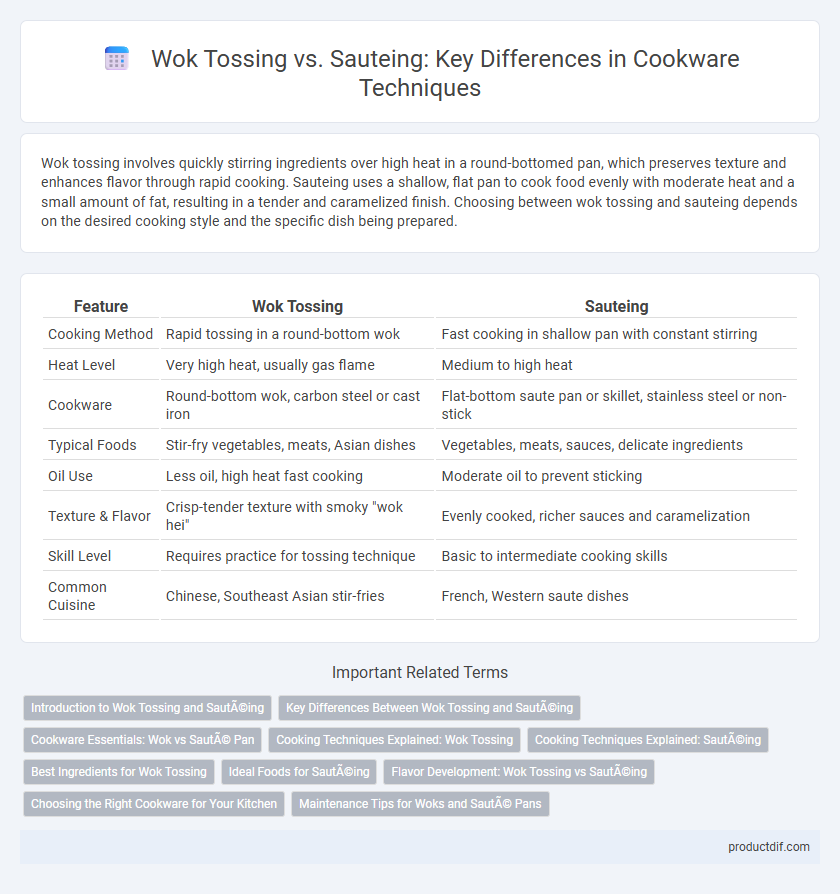Wok tossing involves quickly stirring ingredients over high heat in a round-bottomed pan, which preserves texture and enhances flavor through rapid cooking. Sauteing uses a shallow, flat pan to cook food evenly with moderate heat and a small amount of fat, resulting in a tender and caramelized finish. Choosing between wok tossing and sauteing depends on the desired cooking style and the specific dish being prepared.
Table of Comparison
| Feature | Wok Tossing | Sauteing |
|---|---|---|
| Cooking Method | Rapid tossing in a round-bottom wok | Fast cooking in shallow pan with constant stirring |
| Heat Level | Very high heat, usually gas flame | Medium to high heat |
| Cookware | Round-bottom wok, carbon steel or cast iron | Flat-bottom saute pan or skillet, stainless steel or non-stick |
| Typical Foods | Stir-fry vegetables, meats, Asian dishes | Vegetables, meats, sauces, delicate ingredients |
| Oil Use | Less oil, high heat fast cooking | Moderate oil to prevent sticking |
| Texture & Flavor | Crisp-tender texture with smoky "wok hei" | Evenly cooked, richer sauces and caramelization |
| Skill Level | Requires practice for tossing technique | Basic to intermediate cooking skills |
| Common Cuisine | Chinese, Southeast Asian stir-fries | French, Western saute dishes |
Introduction to Wok Tossing and Sautéing
Wok tossing involves cooking ingredients quickly over high heat in a round-bottomed wok, using a tossing motion to evenly cook and retain texture. Sauteing uses a flat-bottomed pan with moderate to high heat, stirring or flipping ingredients to brown and cook them evenly. Both techniques require precise temperature control and swift movements to enhance flavor and texture in stir-fry dishes.
Key Differences Between Wok Tossing and Sautéing
Wok tossing involves continuously flipping ingredients in a round-bottomed wok over high heat, promoting even cooking and retention of flavors through rapid stirring and movement. Sauteing uses a shallow pan with moderate heat, focusing on evenly cooking ingredients by stirring or flipping with less vigorous motion. The key difference lies in the cooking vessel shape, heat intensity, and motion technique, which affect texture, flavor development, and cooking speed.
Cookware Essentials: Wok vs Sauté Pan
Wok tossing requires a round-bottomed wok made of carbon steel or cast iron, designed to distribute heat evenly and withstand high temperatures for quick, intense cooking. Sauteing relies on a flat-bottomed saute pan with straight sides, often made from stainless steel or non-stick materials, providing even heat and control for browning and reducing sauces. Choosing between a wok and a saute pan depends on cooking technique, heat tolerance, and the desired texture and flavor of the dish.
Cooking Techniques Explained: Wok Tossing
Wok tossing is a dynamic cooking technique that involves continuously flipping ingredients in a high-heat, lightweight wok to ensure even cooking and retain texture. This method uses the wok's curved shape to rapidly sear foods while preserving moisture and flavor, ideal for stir-fries. Unlike sauteing, which relies on constant stirring in a flat pan, wok tossing leverages centrifugal force to distribute heat efficiently and prevent sticking.
Cooking Techniques Explained: Sautéing
Sauteing involves cooking food quickly in a small amount of oil or fat over medium-high heat, typically in a shallow pan, allowing for even browning and caramelization. This technique preserves texture and flavor by continuously stirring or tossing the ingredients to prevent burning and ensure uniform cooking. Commonly used for vegetables, meats, and seafood, sauteing enhances the natural sweetness and develops a rich, complex taste.
Best Ingredients for Wok Tossing
Wok tossing requires high-heat, quick-cooking ingredients like thinly sliced vegetables, bite-sized meats, and firm tofu to ensure even cooking and vibrant texture. Ingredients such as bell peppers, snap peas, mushrooms, and lean chicken or beef strips retain their crunch and flavor when tossed rapidly in a hot wok. Selecting protein and vegetables with low moisture content prevents steaming and promotes the characteristic sear essential for authentic wok-tossed dishes.
Ideal Foods for Sautéing
Sauteing is ideal for cooking tender vegetables, small pieces of meat, and seafood that require quick, even cooking at high heat. Foods like bell peppers, onions, mushrooms, and thinly sliced chicken breasts retain their texture and flavor best when sauteed in a shallow pan with a small amount of oil. This method enhances caramelization and browning, making it perfect for dishes that benefit from a crisp exterior and juicy interior.
Flavor Development: Wok Tossing vs Sautéing
Wok tossing utilizes high heat and quick, continuous tossing to sear ingredients, locking in moisture and enhancing bold, smoky flavors through the Maillard reaction. Sauteing typically involves moderate heat and less vigorous stirring, resulting in a more even caramelization that brings out natural sweetness and subtle depth. Each method influences flavor development distinctly, with wok tossing producing a vibrant, charred taste while sauteing yields rich, golden-browned layers.
Choosing the Right Cookware for Your Kitchen
Wok tossing requires a round-bottomed wok made from carbon steel or cast iron for even heat distribution and the ability to toss ingredients easily. Sauteing benefits from a heavy-bottomed skillet or saute pan with a flat base that ensures stability and consistent heat on any stovetop surface. Selecting cookware that matches your cooking technique enhances heat control and preserves the texture and flavor of your dishes.
Maintenance Tips for Woks and Sauté Pans
Proper maintenance of woks involves seasoning the carbon steel surface regularly to prevent rust and ensure a natural non-stick coating. Saute pans require thorough cleaning without abrasive scrubbers to preserve their non-stick or stainless steel finish, followed by immediate drying to avoid water spots. Both cookware types benefit from occasional oiling after cleaning to maintain surface integrity and performance.
Wok Tossing vs Sautéing Infographic

 productdif.com
productdif.com